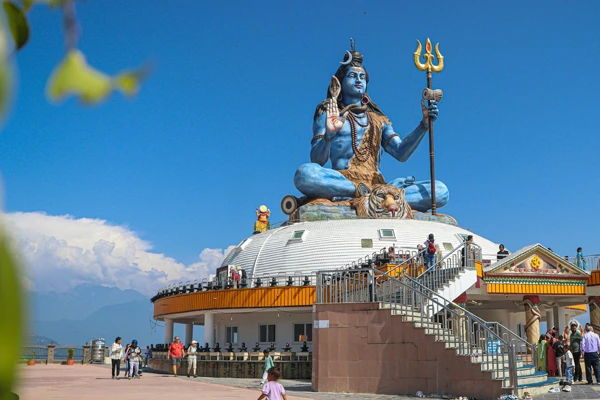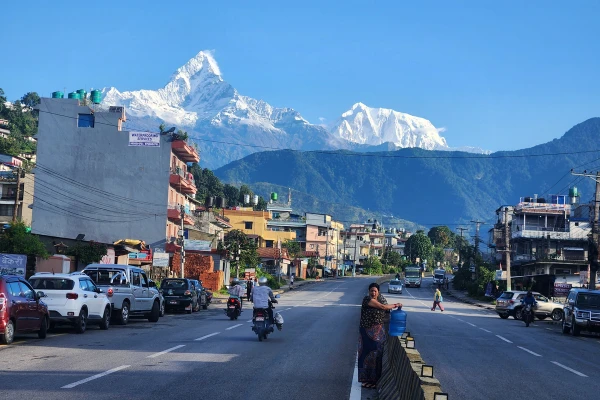Get ready for your next adventure with our ultimate trekking gear checklist. This guide covers everything from choosing the perfect backpack and layering your clothing to essential camping gear and safety equipment. Whether you're tackling a challenging mountain trail or a leisurely forest hike, these trekking essentials will help you stay prepared, comfortable, and safe on your journey. Don’t leave anything behind—ensure your trek is a success with our expert tips and detailed gear list.
Essential Trekking Gears for Nepal
Table of Contents
A trekking expedition is an exciting adventure that brings you closer to nature, tests your stamina, and provides you an opportunity to capture the beautiful nature sceneries. However, to be able to fully maximize the trip and to be safe, preparation is necessary for the basic things that need to be brought when going on a trek. This guide will cover the basics of equipment you need to carry, the trek gear list for the specific trek, and the backpack checklist to follow for a successful trek. From this guide, you will be able to understand all the information that any beginner or an experienced trekker needs for a successful and enjoyable hike.
The Backpack: Your Best Companion
Your backpack is not simply a bag, but the best operational tool during the trekking period. Selecting your backpack is important, you will have all your belongings in it and it can greatly affect your comfort on the trail.
a. Size Matters
Taking your chosen route into consideration, you should remember that for different trails different backpacks are appropriate. For day hikes, for instance, one may not require more than a 20-30 liter pack but for multi-day treks, 50-70 liter backpacks will be ideal. Make sure it comes with a good suspension system that is complemented by well-padded shoulder straps and a good hip belt for weight distribution.
b. Organization and Accessibility
Search for a backpack that has extra pockets and sections in case you have items that need to be accessed frequently such as bottles of water, snacks, and maps. You need a cover that will shield your gear in the event of rain or have a rain fly built in.
c. Essential Items in Your Backpack
- Hydration System: Water bladder or bottles with at least 2-3 liters capacity.
- Navigation Tools: Map, compass, or GPS device.
- First Aid Kit: Include band-aids, antiseptic wipes, blister treatment, and any personal medication.
- Multi-tool/Knife: Useful for various tasks like cutting ropes or opening packages.
- Headlamp or Flashlight: Essential for early starts, late finishes, or emergencies.
- Extra Clothing: Layering is key, so pack lightweight, moisture-wicking layers.
- Rain Gear: A lightweight rain jacket and pants.
- Food: High-energy snacks, packed lunches, or dehydrated meals.
2. Clothing: Dress for Success
Appropriate dressing is one of the basic requirements when going on a trek. Wearing layers is all for the possibility of the change in either the weather or level of intensity and the ability to adapt quickly to either.
a. Base Layer: Moisture Management
Your base layer should pull sweat away from the skin so as not to retain body moisture. Merino wool, synthetic materials, or any lightweight fabric that dries easily and does not allow you to feel cold.
b. Mid Layer: Insulation
The mid-layer comes with the responsibility of providing warmth during any kind of weather. Heavyweight or midweight wool, fleece jackets down vests, or synthetics are ideal to wear. It depends on the extent of heat expected in the trek that you are planning for.
c. Outer Layer: Protection
Your outer layer protects you from the wind, rain, and snow. Essential is a suit of jacket and trousers which is waterproof, windproof and breathable. Both should be compact and easily stowable.
d. Accessories
- Hat and Gloves: Essential for cold weather, even in summer at high altitudes.
- Sunglasses: Protect your eyes from UV rays, especially at higher elevations.
- Gaiters: Useful in snowy or muddy conditions to keep debris out of your boots.
3. Footwear: The Foundation of Your Trek
Your feet support your whole body throughout your hike, so protecting them and cushioning them properly is very important. Socks and shoes that are not properly fitted or appropriate shoes may result in a joyful hike becoming a nightmare.
a. Hiking Boots
Buy a good pair of trekking shoes that protect your feet well and should fit you nicely. Select boots that have good support around the ankle area, they should also be waterproof and should have a strong outsole with a strong grip. Wear them before the trek to reduce instances of blister formation.
b. Socks
Wear moisture-wicking, cushioned socks. Merino wool is a great material that provides warmth, and breathability and reduces the risk of blisters. Carry a few extra pairs, and change them when they become wet or dirty.
c. Foot Care Essentials
- Blister Prevention: Use blister prevention products like moleskin or blister bandages.
- Foot Powder: Helps to keep feet dry and reduce friction.
4. Camping Gear: Home Away from Home
If your trek involves overnight stays, camping gear becomes an integral part of your essential gear list.
a. Shelter
Select a simple tent made of high-quality material that will be resistant to the climate you expect to encounter. This type of tent is reasonable for most treks as it provides shelter from strong winds, wet weather, and bugs.
b. Sleeping Bag
Your sleeping bag should be synthetic because this one will be made at the lowest temperature possible during your stay. Down sleeping bags provide, relative to their weight, good insulation and are warmer than synthetic sleeping bags which are better in wet conditions.
c. Sleeping Pad
Something as simple as a flat cushion is for not only lying down on but also as a protective cushion from the cold, hard ground. For tailored and flexibility inflatable pads are very light and compressible and when it comes to robustness and density the closed cell foam pads are quite excellent.
d. Cooking Gear
If you are preparing to cook your food, a mini stove, fuel, small pots, and kitchen tools are the other things you should carry. Do not forget to carry waterproof matches or a lighter to make the fire ignition process easy.
5. Nutrition: Fueling Your Adventure
What you eat on the trail has a direct impact on your energy levels and overall trekking experience.
a. Meal Planning
Select meals that are rich in calories and at the same time should be easily prepared and should occupy less space. These are dehydrated or freeze-dried meals, instant noodles as well as oatmeal which can be prepared easily in water.
b. Snacks
Sustenance yourself properly and include goodies such as trail mix for energy, energy bar, nuts, and dried fruits. These items are in the above backpack essential list because they can be rolled, and packed and don’t spoil while giving a quick burst of energy.
c. Hydration
One should ensure that he or she takes enough water, this is even more essential if one is at a higher altitude. If you will be replenishing your supply from rivers or lakes, then make it a point to bring a portable water filter or purging tablets. A bottle of electrolyte mix can help fix your energy and also avoid fatigue.
6. Safety and Emergency Gear
As much as people will ensure that all the structures and frameworks have been put in place, contingencies may occur. It is impossible to go without safety and emergency accessories.
a. First Aid Kit
It is always useful to have a first aid kit but ideally, each person should have a first aid kit that can suit his or her own needs. Such things are antiseptic ointment, painkiller drugs, tweezers, scissors, and any prescribed medicines being taken along.
b. Emergency Shelter
An emergency bivy sack or space blanket can be a lifesaver in unexpected situations where you need to spend the night outdoors.
c. Navigation Tools
In addition to a GPS device, always carry a physical map and compass. Knowing how to use them is just as important as having them.
d. Communication Device
Consider carrying a satellite phone or personal locator beacon (PLB) in remote areas where mobile service is unreliable. It’s also wise to let someone know your trekking route and expected return time.
e. Fire Starter
In case of emergency, a reliable fire starter is crucial. Waterproof matches, a lighter, or a fire steel should always be in your pack.
7. Environmental Responsibility: Leave No Trace
As trekkers, we are wholly focused on the natural surroundings, and being a considerate traveler means doing everything possible to not disturb nature’s balance.
a. Waste Management
Take out all cans and empty food remains and bury all human waste at a distance of not less than 200 feet from the water source. Anyone using soap for washing should use only the biodegradable kind and should not pollute the water sources.
b. Respect Wildlife
Do not get too close to any animals or approach them, do not feed animals. The conservation of wild animals remains one of the ways of conserving the natural world.
c. Stick to Trails
Treading off-trail impacts and creates erosion in an area and also destroys the natural environment. Always stick to posted trails to avoid erasing tracks made by wildlife.
8. Preparing for the Unexpected
However, in any planning, it is always useful to expect the unexpected even if you have planned very well as espoused in the succeeding sections. Day-to-day weather could be unpredictable and therefore requires needs and challenges may present themselves along the way.
a. Weather Awareness
Before your trek always check on the weather because it can change drastically at any one time. We recommend packing one or two additional clothes, such as warmer, raincoats, and something to do in case the hike has to be abandoned halfway.
b. Emergency Plan
Be prepared in case of emergency and should have a backup plan well developed. This includes knowledge of the emergency health care facilities, having an emergency contact person, and an awareness of the risks in the trek.
c. Mental Preparedness
The formula of trekking may be physically stressful but it might also be dangerous mentally. Practical advice includes being optimistic and not hesitating to take a break of any duration especially if the conditions are unfavorable and that it is alright to turn back when the conditions are unfavorable.
9. Final Checklist: The Trek Gear List
Before you head out, review your essential gear checklist to ensure you haven’t forgotten anything:
- Backpack: Suitable size with a rain cover
- Footwear: Broken-in hiking boots, moisture-wicking socks
- Clothing: Base, mid, and outer layers, hat, gloves
- Camping Gear: Tent, sleeping bag, sleeping pad, stove
- Nutrition: Lightweight meals, snacks, hydration system
- Safety Gear: First aid kit, emergency shelter, navigation tools, fire starter
- Personal Items: Sunscreen, insect repellent, toilet paper, hygiene items
- Environmental Gear: Trash bags, biodegradable soap
Conclusion
Trekking is a fun and fulfilling activity though this activity should be planned and done systematically. If you follow this basic list of trekking gear checklist you will be able to have proper trekking gear on and therefore, enjoy a safe and fruitful adventure. Whether you are out for a three-peak climb along the Himalayas or a two-day trek up to the nearby mountain ranges, those items that are considered trek essentials are the key determinants to the success or failure of the trekking expedition. Thus, dress up, pack the rucksack, set the trek up, and enjoy the moments that you capture on your next trek!
Hence, this guide is expected to be a comprehensive one for all trekkers regardless of their experience level. By so doing effectively choosing the best gear accompanied by the checklist outlined here will help you maximize your trekking adventure. Happy trekking!
Final Checklist:
1. T-shirt ( full and half sleeve )
2. Fleece jacket
3. Wind cheater
4. A bit thick jacket. (Down preferably to beat the cold at 4000 – 5000 Meters or above depending on your choice of route :)
5. Hiking pants
6. Trekking boots: Investing on a nice waterproof light boots is always the most important part.
7. Sandals/ comfortable non-slippery slippers which can be used with socks : Well, nothing beats the wonderful
8. Warm cap
9. Scarf to save you from having cracked cheeks.
10. Water bottle and water purifier tablets is always wonderful in saving money and not polluting the mountains with more plastic waste. Carrying a thermos should also be helpful if you prefer drinking hot water while being exposed to cold temperatures.
11. Day pack for yourself.
12. Gloves
13. Torch (preferably headtorch): Don’t forget a Headlamp which should be helpful in many cases. Carrying spare batteries is always useful.
14. Sunscreen, lotion
15. Lip balm
16. Toiletries ( paper towel, soap, shampoo, quick drying hiking towel )
17. Raincoat/poncho
18. A nice sleeping bag should help you in getting a good sleep after the long day’s trek.
19. Carrying a powerbank or solar charger saves you a great deal.
20. Hiking Poles come handy and support a lot during the trekking.

.webp)



